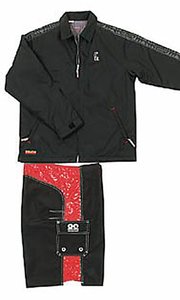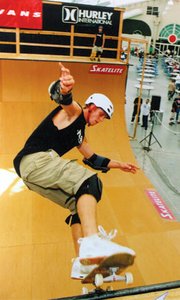Surf's Style, Skate's Accessibility
Boardsports, or action sports, the group label for surf, skate and snowboarding, are currently pursued by more than 20 million Americans, according to Board-Trac, an Orange County, Calif.-based market research company that tracks the lifestyles and purchasing habits of young people between the ages of 12 and 24 who participate in or are influenced by boardsports.
Boardsports represent $9.9 billion in annual revenue, with roughly 80 percent of that coming from sales of related clothes, shoes and accessories.
One of the largest contributors to the strength of action sports is the growth of skateboarding in recent years. In the early 1990s, skateboarding participation had declined to less than 5 million participants; however, according to Board-Trac’s research, that figure has more than doubled since then.
“What this means is that skateboarding is having a tremendous impact on action sports, retail sales and fashion,” said Angelo Ponzi, president of the Ponzi Group, a marketing support services firm based in Trabuco Canyon, Calif., which developed Board-Trac.
Though skateboarding counts as the dominant action sport in terms of the number of participants in it, boardsports are still driven by the image and influence of the surf lifestyle, according to Marie Case, partner and managing director of Board-Trac.
“Surfing has always had a mystique around it because it is not accessible to everyone on the planet,” said Case. “You have to live near an ocean to surf, and because of its inaccessibility it has been coveted, especially among young kids who want to be a part of that lifestyle—whether they live near the beach or not. The only way they can do that is by buying the clothing that reflects the image of surfing.”
According to the most recent Board-Trac study, there are over 10 million skateboarders, with the number of snowboarders approaching 8 million and surfers trailing with 2.5 million participants.
Case said that skateboarding—what she calls the “driving force” of boardsports—is so huge because of its accessibility for urban youth.
“Those numbers are huge because you can put your board down on any piece of concrete,” she said, adding, “But still surfing dominates because it has a great image and resonates in any neighborhood. It really is about the beach lifestyle.”
The growing number of females participating in boardsports—specifically skateboarding—lends to that segment’s strength. There are still more females snowboarding and surfing than skating, but the percentage of female skaters has risen over the past five years, Case said.
“The sport that will drive the direct sale is skate,” said Case. “More girls are participating and you don’t need an ocean or mountain to do it.”
And that’s what Greg Weaver, chairman and chief executive officer of Pacific Sunwear, is counting on. Weaver said that he plans to lead his company in stronger targeting of the female segment.
“Our marketing efforts over the past couple of years have been very male-oriented,” he said. “It’s been very edgy, very extreme sports–oriented.”
Weaver said that Pacific Sunwear will have to soften its approach to reach the female customer.
“Girls don’t want to be thought of as being on the back end of a skateboard going down the hill,” said Weaver. “They want to be perceived [as being] on the front end. I need to focus on some really good-looking product that is low-rise and that is sexy.”
Board-Trac estimates that females account for some 9 percent to 11 percent of the skateboard market, 22 percent to 25 percent of the snowboard market and 20 percent to 23 percent of the surf market.
Quiksilver, the Costa Mesa, Calif.-based surf giant, successfully built its Roxy label as a junior fashion brand with its soul in the surf world.
Case said that the success of Quiksilver can be directly traced to its ability to identify and follow the core of boardsports, which has meant diversifying its offerings to include emerging target groups.
In addition to the core Quiksilver surf brand and the Roxy line for the junior market, the company also produces Silver Edition, a men’s line created for the older Quiksilver customer, and Tony Hawk, a boys’ skate line named after one of the preeminent pro skaters. Despite a well-received launch, the company’s contemporary offering, Alex Goes, has been shuttered. According to Bob McKnight, Quiksilver chairman and CEO, Alex Goes is temporarily on the backburner while the company focuses on stabilizing Roxy.
Case credits Quiksilver’s success to the company’s adherence to “the surfing image” while still carving out new segments within the market.
As an example, Case pointed to the Tony Hawk line, which is targeted at pre-adolescent boys, a group that constitutes a new growth market.
“That’s a big bulge in the population right now and those kids are going to drive this economy for decades to come,” Case said. “Any company that is looking at girls and looking at boys [ages] 8 to 15 will be successful for decades to come. It’s smart for any brand to target that age range. Hawk is doing that.”
Quiksilver usually conducts long-term tests on a new line before rolling it out completely. The company tested Roxy for five years and its Silver Edition collection has been in test mode for more than a year. This product-testing stage allows the company to hone its brand positioning and make any necessary changes.
The company tested the Tony Hawk line for roughly a year before making the decision to reposition it.
“We launched Hawk about a year and a half ago,” said McKnight. “We intended it to be a young men’s brand. What we found is that the kids who have Tony [Hawk] as their hero are the 8- to 12-year-old kids. We had to reposition it into the boys’ area over the last two seasons and it’s been successful. We think we’re set for some nice growth over the next couple of years.”
Snow Growth
Skateboarding is the dominant action sport in terms of sales, but the segment with the strongest growth is snowboarding. Between 1999 and 2000, snowboarding participation increased 51.2 percent, skateboarding participation increased 49.2 percent and participation in surfing went up 25.6 percent, according to Board-Trac’s most recent survey.
Snowboarding is on a tear. Part of that is due to the fact that it’s a relatively new sport gaining in popularity. But Case also points to the parallels between skateboarding and snowboarding as helping boost interest in the latter activity.
“A lot of the skate kids are snowboarding,” he said. “Their parents ski, but they snowboard. The kids aren’t skiing anymore. I think [snowboarding] requires a little less skill. The kids that are coming off of a skateboard—the motion is a lot similar. It’s a single board.”























